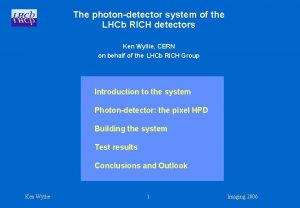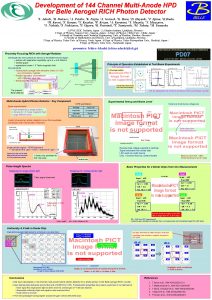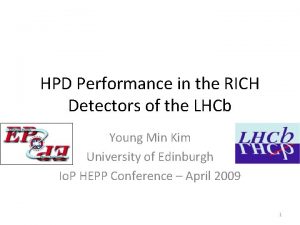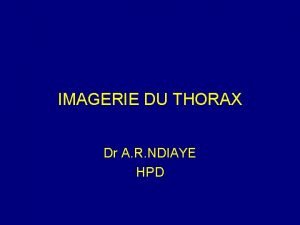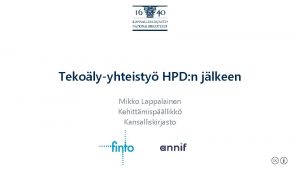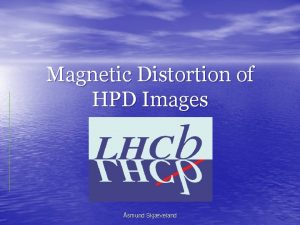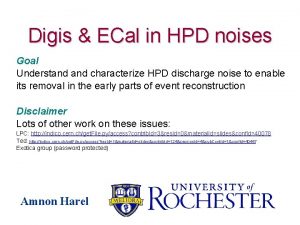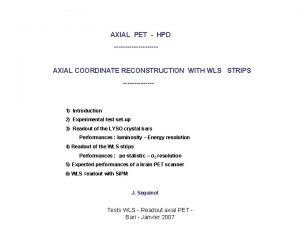Development of HPD n n Photondetector for the


















![Readout Electronics n Basic parameters for the ASIC (Rohm CMOS 0. 35[μm]) n n Readout Electronics n Basic parameters for the ASIC (Rohm CMOS 0. 35[μm]) n n](https://slidetodoc.com/presentation_image_h/2015ae485a57d54502f9cd6d0486612f/image-19.jpg)


- Slides: 21

Development of HPD(HAPD) n n Photon-detector for the Aerogel RICH Development of HPD and HAPD Ø n n Aerogel Radiator Position sensitive Photon Detector Cherenkov photons Concept of the Aerogel RICH Prototype Test Readout Electronics PID upgrade for the Summary forward end-cap region. 30, Nov. 2004 RICH04@Playa del Carmen e- e+ T. Sumiyoshi (TMU) 1

Photon-detector for the Aerogel RICH n Requirements Ø Ø n Can detect a single-photon with high efficiency. Have sensitivity to ~ 400 nm photons from aerogel radiators (due to Rayleigh scattering). Can detect the position of photons with a resolution ~ a few mm. Immune to the high magnetic field (1. 5 Tesla). HPD or HAPD may be the best candidates for the Photondetector of the Aerogel RICH. n n Fine-mesh PMT: Poor resolution for single photons. MCP-PMT: 60% collection efficiency. 30, Nov. 2004 RICH04@Playa del Carmen T. Sumiyoshi (TMU) 2

Development of HPD and HAPD n n e- Photons Develop a multi-anode HPD/HAPD with proximity focus. Make the effective area as large as possible. Photocathode 8 k. V HV Output PD/APD DEP catalogue 30, Nov. 2004 RICH04@Playa del Carmen T. Sumiyoshi (TMU) 3

Development of HPD and HAPD n Multi-anode (144 ch) HPD/HAPD are under development in the cooperative work between Belle and HPK. Outer: 72 x 72 mm 2 Effective : 59 x 59 mm 2 (65%) Multi-anode: 12 x 12=144 ch. Pixel Size: 4. 9 x 4. 9 mm 2 30, Nov. 2004 RICH04@Playa del Carmen T. Sumiyoshi (TMU) 4

Prototype Test -Single Channel HPDn Single channel HPD n n Leak current : 4 [n. A] Detector capacitance : 20 [p. F] Gain (8 k. V) : 1500 [electron/photon] Bias voltage : 80 [V] 2 pe 3 pe 1 pe 4 pe Sensitive area:φ8[mm] Fig. 2 ; singleRICH04@Playa photon response del & multi photon response T. Sumiyoshi (TMU) 30, Nov. 2004 Carmen 5

Prototype Test - 3× 3 multi-channel HAPD 53 φ n Single-channel HPD n Diode : □ 5 [mm/ch] Gain : 26000 [electron/photon] Cd : 73 [p. F] IL : 14 [n. A] (average/ch) n Condition: VHV=8[KV], VBIAS=320[V] n n n 15mm 2 pe 3 pe 1 pe 4 pe Although the gain of the HAPD is higher than the HPD, noise level is also higher due to its large detector capacitance. The HPD shows better single photon resolution. 30, Nov. 2004 RICH04@Playa del Carmen 2 pe 1 pe 3 pe 4 pe T. Sumiyoshi (TMU) 6

Structure of HPD and HAPD n Two types of photodiodes are under development for the 4 x(6 x 6) type HPD/HAPD. n APD: surface irradiation type. n PD ; back irradiation type. Can reduce dead area btw pixels (0. 2 ->0. 1 mm) Photo electron APD p n n p Surface irradiation type 30, Nov. 2004 PD Back irradiation type RICH04@Playa del Carmen T. Sumiyoshi (TMU) 7

Total gains of HPD and HAPD n Gain vs PC Voltage. 30, Nov. 2004 RICH04@Playa del Carmen T. Sumiyoshi (TMU) 8

Development of HPD and HAPD n Leakage current vs Bias voltage. 30, Nov. 2004 RICH04@Playa del Carmen T. Sumiyoshi (TMU) 9

Timing structure of HPD and HAPD n Rise time 30, Nov. 2004 RICH04@Playa del Carmen T. Sumiyoshi (TMU) 10

Dead region of HPD and HAPD n Dead region between the pads. 30, Nov. 2004 RICH04@Playa del Carmen T. Sumiyoshi (TMU) 11

Development of HPD and HAPD n Basic performance has been studied with the 3 x 3 type HPD /HAPD. n n 3 x 3 ch HPD n No serious problem n Higher EB gain than expected (1500 -> 2100). 3 x 3 ch HAPD n Low yield of good quality APD’s. n There is a HV leak from photocathode. n High gain but very noisy. n Further investigation is underway with a new production batch. Leakage current before and after activation of PC. HPD HAPD 30, Nov. 2004 RICH04@Playa del Carmen T. Sumiyoshi (TMU) 12

Development of a 12 x 12 HAPD n Production of 12 x 12 multi-anode HAPD. n 4 x (6 x 6) APD is assembled in this bulb by a transfer technology. 73 mm n After the activation many APD’s can’t sustain nominal bias voltage 380 V. 30, Nov. 2004 RICH04@Playa del Carmen T. Sumiyoshi (TMU) 13

Response of the 12 x 12 HAPD n Response to a single photoelectron and multi-photoelectrons. Single Photoelectron 30, Nov. 2004 RICH04@Playa del Carmen Multi Photoelectron T. Sumiyoshi (TMU) 14

Uniformity of a 6 x 6 APD EB gain <1660>@-8 k. V Photocathode 30, Nov. 2004 RICH04@Playa del Carmen T. Sumiyoshi (TMU) 15

Uniformity of a 6 x 6 APD Total gain <2. 6 x 104> Avalanche gain <15> 30, Nov. 2004 RICH04@Playa del Carmen T. Sumiyoshi (TMU) 16

Uniformity of a 6 x 6 APD Over all response QE x gain 30, Nov. 2004 RICH04@Playa del Carmen T. Sumiyoshi (TMU) 17

Readout Electronics Total number of readout channels for the full detector amounts to 120 k. n Detector characteristics n Leakage current 10 or 25[n. A] n Detector capacitance ; 10 or 70 [pF/pixel] n signal; 2000 or 20000 [electron/photon] n Need high density front-end electronics. n Need high gain with very low noise amplifiers. n Deadtimeless readout scheme-> Pipeline. n Develop an ASIC for the front-end electronics 30, Nov. 2004 RICH04@Playa del Carmen T. Sumiyoshi (TMU) 18
![Readout Electronics n Basic parameters for the ASIC Rohm CMOS 0 35μm n n Readout Electronics n Basic parameters for the ASIC (Rohm CMOS 0. 35[μm]) n n](https://slidetodoc.com/presentation_image_h/2015ae485a57d54502f9cd6d0486612f/image-19.jpg)
Readout Electronics n Basic parameters for the ASIC (Rohm CMOS 0. 35[μm]) n n n n Gain: 5 [V/p. C] Shaping time: 0. 15 [μs] VGA: 1 -16 S/N : 8 (@2000[e]) Readout :pipeline with shift register Package : 18 channels/chip Control : LVDS Power consumption : 5 m W/channel Made through VDEC □ 4. 93[mm] Preamp Shaper 30, Nov. 2004 VGA Comparator RICH04@Playa del Carmen Shift register T. Sumiyoshi (TMU) 19

Readout Electronics n Current noise performance n n n Threshold behavior. 4000 enc: about twice of SPICE simulation. It could be made half in the next iteration. 30, Nov. 2004 RICH04@Playa del Carmen n It works as expected. T. Sumiyoshi (TMU) 20

Summary n n 12 x 12 HAPD is under development for the photon detectors of the proximity focusing RICH which is a good candidate of the Belle PID system in future. There still remains some problems: n n n APD leakage current goes up after the activation of PC. Some APD can’t keep nominal bias voltage. For a readout of many anode signals (120 k ch. ), we have been developing an ASIC. n n Basic performance was checked by test pulses. Need minor modification for a further improvement of noise level (current S/N 5 → 8). 30, Nov. 2004 RICH04@Playa del Carmen T. Sumiyoshi (TMU) 21
 Ihe hpd
Ihe hpd Hpd design guidelines
Hpd design guidelines Hpd homeless outreach team
Hpd homeless outreach team Hpd enforcement desk bed bugs
Hpd enforcement desk bed bugs Hkr 114 uitm
Hkr 114 uitm Hpd cif online form
Hpd cif online form Steg för steg rita
Steg för steg rita Vilken grundregel finns det för tronföljden i sverige?
Vilken grundregel finns det för tronföljden i sverige? Ministerstyre för och nackdelar
Ministerstyre för och nackdelar Tillitsbaserad ledning
Tillitsbaserad ledning Plats för toran ark
Plats för toran ark Nationell inriktning för artificiell intelligens
Nationell inriktning för artificiell intelligens Bästa kameran för astrofoto
Bästa kameran för astrofoto Rim texter
Rim texter Nyckelkompetenser för livslångt lärande
Nyckelkompetenser för livslångt lärande Ro i rom pax
Ro i rom pax Mästar lärling modellen
Mästar lärling modellen Matematisk modellering eksempel
Matematisk modellering eksempel Jätte råtta
Jätte råtta Personalliggare bygg undantag
Personalliggare bygg undantag Verktyg för automatisering av utbetalningar
Verktyg för automatisering av utbetalningar Shivaismen
Shivaismen























